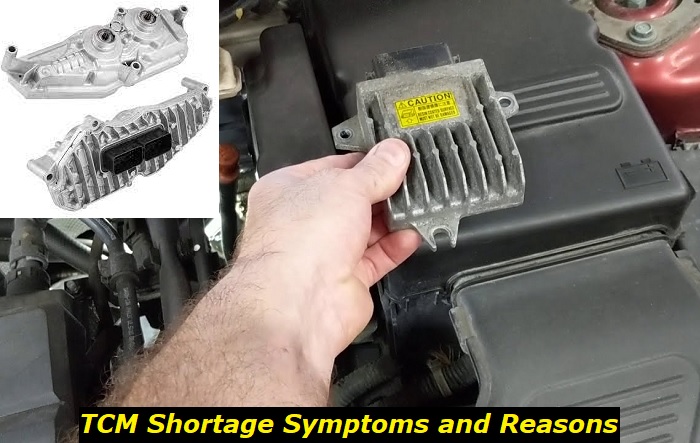The common symptoms of a transmission control module fault include the check engine light (CEL) or transmission warning light coming on as well as shifting problems. You can notice the lights illuminating on the dashboard of your car.
Transmission issues highlights
- Level of importance:Medium
- Reasons:TCM problems, low fluid, shifter issues
- Needed expertise:High
- Needed tools:Professional tools set
- Time taken:3-8 hours
- Can you drive? Yes, if possible
- Possible issues:Torque converter damage, overheating, TCM damage.

Transmission Control Module Description
New model-year cars rely on transmission control modules rather than mechanical or hydraulic transmission control. In other words, TCMs are for vehicles that utilize automatic transmission systems.
The module is the brain of your car's transmission and it's an electrical unit. It interacts with a variety of vehicle sensors and parts to ensure that there's smooth and efficient gear shifting as you drive. It also helps to ensure good fuel economy, minimize wear and tear, and improve shift quality.
TCMs get data from the throttle position sensors, speed sensors, engine load, etc. The data is then interpreted and utilized in calculating proper timing and gear shifting for the vehicle. Your car's transmission will know when to downshift or upshift as your drive.
A typical TCM looks like a small plastic or metallic hard drive that features a data port on the side. It can be flat, squared, and/or structured with ridged edges. But the form may be different based on the vehicle model.
Symptoms of a Bad Transmission Control Module
A TCM that misbehaves must be checked as soon as possible. Driving while noticing the signs of a malfunctioning module isn't a risk worth taking. Look out for the following possibly related symptoms:
1. The Check Engine Light or Transmission Warning Light Coming On
Many possibilities can trigger the CEL or transmission warning light to come on. And a TCM defect is one of them. You could easily link the alerts to any shifting issue you're having while driving.
Scanning for a diagnostic trouble code (DTC) using a scan tool may bring out the P0700 or U0100 error code. This result may be pointing at a TCM defect.
2. Shifting Problems
There are a variety of shifting issues that may occur when the module is not in good working condition. They include unpredictability, delays, difficulty upshifting or downshifting, and getting stuck in a gear.
Unpredictable shifting is when the change in gears is unintended or deemed incorrect by the driver. It might feel like the vehicle is jerking when increasing its speed or pulling back when in motion. Your car may also switch to neutral abnormally or without cause.
Being stuck in a gear typically means that you can't switch from first gear or neutral. This means that you'll be restricted by the speed of the first gear or you won't be able to move the car because it's in neutral.
3. Bad Fuel Economy
A transmission system issue may lead to reduced fuel efficiency because of abnormal gear switching and timing. This means that your engine will be pushed to stress itself more than normal. And that will only result in the increased consumption of fuel.
4. Limp Mode
The vehicle getting stuck in limp mode is an obvious sign of a defective module. Limp mode is supposed to stop your car from switching to higher gears, thereby restricting the vehicle's speed and power.
Most cars are equipped with this safety feature. It's activated when the TCM detects a critical transmission fault, sends wrong messages, or just ceases to interact with other control units.
Reasons for Transmission Control Module Faults
See 5 sources of transmission control unit malfunctions below.
1. Wear and Tear
The older your car gets, the more its components experience wear and tear. Usage, weather, corrosion, road conditions, poor maintenance, and so on are also factors to consider as well. So the condition of your TCM is likely to be influenced by some of these determinants.
2. Bad Cable Connections
The TCM is connected to the ECU/ECM by wiring, right? So there'll certainly be an issue or malfunction when that connection is compromised by a short. For example, a short may be caused by overloading or burns. Look for any part of the link where there are signs of fraying, decay, or cuts.
3. Overheated Engine
A TCM's electronic components can get damaged by adverse engine temperatures. The plastic or metallic covering might not be adequate for protecting the unit from the heat.
4. Vibrations
This is another factor that isn't favorable to the module's electronic parts. But your car is bound to experience excess vibration when its engine RPM or wheel speed increase. Collisions, bumps, and uneven terrains can also make the vehicle vibrate abnormally and affect the unit negatively over time.
5. Incorrect Soldering in the Circuit Board
Bad soldering can cause the module to get faulty or fail. Thankfully, your warranty may cover the fix if the car is still under warranty or brand new.
Checking a Transmission Control Module
A simple way to test a transmission control module is by observing how your car is moving or shifting. But you can find the unit and do a physical examination instead to discover physical signs of a fault.
The module's location is typically around or in the engine. But it could be around or on the transmission too. Although this varies from car to car. It will have a cable connection to the vehicle's computer, that is, the electronic control unit (ECU) or electronic control module (ECM). This link will run from the TCM's data port.
You can first switch off the car, then try to restart it. TCM faults aren't supposed to stop a vehicle from starting. So you may have to look for a different type of fault if your car won't restart.
Replacing a Bad Transmission Control Module
It will cost you $300-$500 to get a replacement TCM online. Although you can get it for way cheaper at a junkyard (down to $40). Hiring a mechanic could mean that you'd be paying between $50 to $200, depending on the shop type and car type.
TCM Replacement Procedure
You may not need to use any equipment to uninstall the module, depending on your car model. But tools that may become relevant in other cases include a small towel (for wiping off dust and debris), screwdrivers, and socket wrenches. Now see the transmission control module replacement steps below.
Step 1: Buy a Compatible TCM
Ensure that you purchase a module that's suitable for your vehicle's make and model year. Aftermarket TCMs aren't one-size-fits-all or universal.
Step 2: Locate the Module
Look for the module around the engine or transmission, as stated earlier. This means you'd have to flip open your car hood. The TCM will feature a cable connecting a data port to the ECU/ECM.
Sometimes, the TCM could be situated below the cover behind the transmission case. It could also be below the ECU/ECM's position. Other possible locations are listed below.
- Under the dash near the firewall
- Under the center console in the interior
- Close to the battery
- Near the inner fender panel
- Close to the glovebox
Don't begin to find the TCM's location of your car by taking components apart, if you didn't know the place beforehand. You should rather read the vehicle owner's manual or vehicle-specific service manual to get the needed information.
Step 3: Uninstall the Module
You can now remove the old unit by lifting the plastic tab or screws/bolts that keep it in place. Proceed to disconnect the cable plugged into the TCM's data port.
Step 4: Connect the New Module
This step can simply be carried out by doing a reverse of the previous steps. Ensure that the plastic tab, screws, or bolts are fixed back securely. End the process by reconnecting the wiring to the module's data port.
DIY replacement durations shouldn't exceed 10-20 minutes, depending on how many components you'd need to clear out while reaching for the unit. It also depends on whether the module is inside the engine or around it.
You won't have to program the replacement transmission control module if it's for the same make and model year of your car. The manufacturer would have already performed this role.
Conclusion
You shouldn't drive with a defective transmission control module. This is because shifting problems alone can expose you to the risk of collision and other dangers while driving. For example; when driving on the freeway and the vehicle shifts to neutral all of a sudden or doesn't downshift when you want to slow down.
Stop the car and park it safely, then find a way to resolve the issue. You may have to get the vehicle towed or call a mechanic to the spot unless there's a manual override option such as paddle shifters. While waiting, you can try to find out what's wrong with the car with the aid of a scan tool or DIY physical checks.
About the authors
The CarAraC research team is composed of seasoned auto mechanics and automotive industry professionals, including individuals with advanced degrees and certifications in their field. Our team members boast prestigious credentials, reflecting their extensive knowledge and skills. These qualifications include: IMI: Institute of the Motor Industry, ASE-Certified Master Automobile Technicians; Coventry University, Graduate of MA in Automotive Journalism; Politecnico di Torino, Italy, MS Automotive Engineering; Ss. Cyril and Methodius University in Skopje, Mechanical University in Skopje; TOC Automotive College; DHA Suffa University, Department of Mechanical Engineering






Add comment